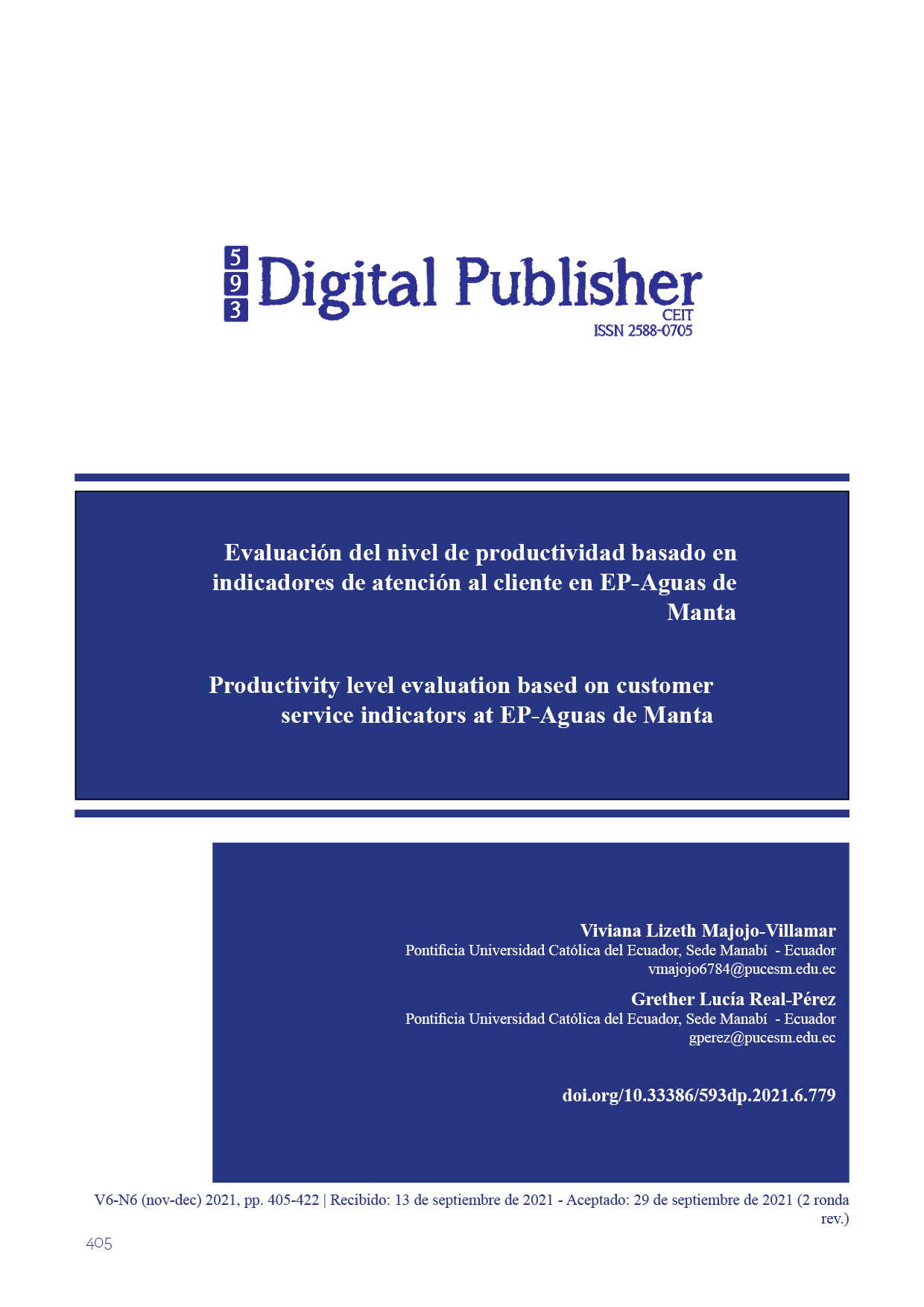Productivity level evaluation based on customer service indicators at EP-Aguas de Manta
Main Article Content
Abstract
The main objective of this research was to propose the implementation of indicators for evaluating the level of productivity in customer service. Within the diagnosis carried out, the indicators that are currently applied by the public company Aguas de Manta were known, the analysis of the databases was developed with the data of the attention times, number of users attended, times of attention of claims, satisfaction of attention of the consultants, for the evaluation of the productivity of the area. Once the information is collected, an analysis and interpretation of the data obtained with the indicators that are applied in the service management area is carried out, for the evaluation of productivity and with this a diagnosis of the current situation was made that allowed to carry out actions to improve. In relation to the evaluation and diagnosis, the implementation of indicators is proposed that allows to measure the levels of performance, effectiveness, and efficiency of the processes in order that the company can take actions to improve the expected results, because from there all citizenship requirements and requests are entered. The type of research used is descriptive, with a non-experimental design, where the information is used, without intervening in obtaining the data. The methodology is of mixed scope, quantitative with the deduction dimension, where the findings found in the development of the investigation are analyzed and identified with the collection of information in the public company Aguas de Manta and with documentary sources. This research investigates the indicators and is scientifically based with a documentary review of articles, scientific journals, and publications that will have the theoretical basis of authors who have contributed with their research.
Key words: customer service indicators; Aguas of Manta; data analysis
Downloads
Article Details

This work is licensed under a Creative Commons Attribution-NonCommercial-ShareAlike 4.0 International License.
1. Derechos de autor
Las obras que se publican en 593 Digital Publisher CEIT están sujetas a los siguientes términos:
1.1. 593 Digital Publisher CEIT, conserva los derechos patrimoniales (copyright) de las obras publicadas, favorece y permite la reutilización de las mismas bajo la licencia Licencia Creative Commons 4.0 de Reconocimiento-NoComercial-CompartirIgual 4.0, por lo cual se pueden copiar, usar, difundir, transmitir y exponer públicamente, siempre que:
1.1.a. Se cite la autoría y fuente original de su publicación (revista, editorial, URL).
1.1.b. No se usen para fines comerciales u onerosos.
1.1.c. Se mencione la existencia y especificaciones de esta licencia de uso.
References
Abad, G., & Pincay, D. (2014). Análisis de la calidad del servicio al cliente interno y externo para propuesta de modelo de gestió de calidad en una empresa de seguros de Guayaquil. Universidad Politécnica Salesiana, Guayaquil.
Aravena, C., & Fuentes, J. (2013). El desempeño mediocre de la productividad laboral en América Latina: una interpretación neoclásica. Naciones Unidas. Obtenido de https://www.cepal.org/sites/default/files/publication/files/5373/LCL3725.pdf
ARCA. (2016). Regulación Nro. DIR-ARCA-RC-003-2016. Quito. Obtenido de http://www.regulacionagua.gob.ec/wp-content/uploads/downloads/2016/04/reg_03_bn.pdf
Arévalo, D., Nájera, S., & Piñero, E. (2018). La Influencia de la Implementación de las Tecnologías de información en la Productividad de Empresas de Servicios. scielo, 210. Obtenido de https://scielo.conicyt.cl/pdf/infotec/v29n6/0718-0764-infotec-29-06-00199.pdf
Bonnefoy, J., & Marianela, A. (2005). Indicadores de desempeño en el sector público. Santiago de Chile: Copyright. Obtenido de https://repositorio.cepal.org/bitstream/handle/11362/5611/S05900_es.pdf
Cano, G. (2018). Las TICs en las empresas: evolución de la tecnología y cambio. Dialnet. Obtenido de file:///C:/Users/CompuStore/Downloads/Dialnet-LasTICsEnLasEmpresas-6313252.pdf
Cárdenas, M., Cortés, F., Escobar, A., Naahmad, S., Scott, J., & Teruel, G. (2014). Manual para el Diseño y la Construcción de Indicadores. Instrumentos principales para el monitoreo de programas sociales de México. México. Obtenido de https://www.coneval.org.mx/Informes/Coordinacion/Publicaciones%20oficiales/MANUAL_PARA_EL_DISENO_Y_CONTRUCCION_DE_INDICADORES.pdf
Carro, R., & Daniel, G. (2012). Productividad y competitividad. Obtenido de http://nulan.mdp.edu.ar/1607/1/02_productividad_competitividad.pdf
Castillo, E. (2010). Teletrabajo, una opción de productividad y eficiencia real para las organizaciones. Virtual Universidad Católica del Norte.
Chaman, M., & Puente, M. (2011). Mejoras en el área de atención a clientes corporativos de una empresa de telecomunicaciones. Industrial Data, 14(1), 055–061. https://doi.org/10.15381/idata.v14i1.6211
CONEVAL. (2013). Manual para el diseño y la construcción de indicadores Instrumentos principales para el monitoreo de programas sociales de México. México.
Contrerasa, O., & Rozo, I. (2015). Teletrabajo y sostenibilidad empresarial. Una reflexión desde la gerencia del talento humano en Colombia. Suma de revistas.
(2020). El teletrabajo durante la pandemia de COVID-19 y después de ella. Ginebra: Copyright.
Garcia, M. (2007). La innovación tecnológica como factor de competitividad empresarial. Obtenido de file:///C:/Users/CompuStore/Downloads/Dialnet-LaInnovacionTecnologicaComoFactorDeCompetitividadE-2524044%20(1).pdf
Grajales, T. (03 de 27 de 2000). TIPOS DE INVESTIGACION. Obtenido de https://cmapspublic2.ihmc.us/rid=1RM1F0L42-VZ46F4-319H/871.pdf
INEC. (2020). Directorio de Empresas y Establecimientos 2019. Ecuador. Obtenido de https://www.ecuadorencifras.gob.ec/documentos/web-inec/Estadisticas_Economicas/DirectorioEmpresas/Directorio_Empresas_2019/Principales_Resultados_DIEE_2019.pdf
Martin, P. (2018). Teletrabajo y comercio electrónico. España: Ministerio de Educación de España. Obtenido de https://elibro.puce.elogim.com/es/ereader/puce/49474
Mondragón, A. (2002). INEGI. Obtenido de INEGI: http://dsp.facmed.unam.mx/wp-content/uploads/2013/12/Que-son-los-indicadores-2019-20.pdf
Najul, G. (2011). El capital humano en la atención al cliente. Universidad de Carabobo. Obtenido de https://www.redalyc.org/pdf/2190/219022148002.pdf
OIT, & Eurofound. (2019). Trabajar en cualquier momento y en cualquier lugar: consecuencias en el ámbito laboral. Chile: Publicaciones de la Unión Europea. Obtenido de https://www.ilo.org/wcmsp5/groups/public/---americas/---ro-lima/---sro-santiago/documents/publication/wcms_723962.pdf
Ordoñez, K., & Zaldumbide, D. (2020). La calidad del servicio al cliente como ventaja competitiva en las microempresas de servicio. Digital Publisher. Obtenido de https://www.593dp.com/index.php/593_Digital_Publisher/article/view/310/506
Pita, F., & Pértegas, D. (2020). Investigación cuantitativa y cualitativa. 1. Obtenido de http://fisterra.com/mbe/investiga/cuanti_cuali/cuanti_cuali2.pdf
Prokopenko, J. (1989). Gestión de la productividad. Copyright. Obtenido de https://d1wqtxts1xzle7.cloudfront.net/38639804/Libro-Productividad-Prokopenko.pdf?1441160724=&response-content-disposition=inline%3B+filename%3DGestion_de_la_productividad.
pdf&Expires=1624163185&Signature=II8Py0~VN0GWsnJqRf0pu569i210E7Lydvlbf6WYIiCH3wHp8T
Rodríguez, F., & Luis, G. (1991). Indicadores de calidad y productividad en la empresa. Venezuela: Nuevos tiempos. Obtenido de https://scioteca.caf.com/bitstream/handle/123456789/863/Indicadores%20de%20calidad%20y%20productividad%20en%20la%20empresa.PDF
Salgueiro, A. (2015). Indicadores de gestión y cuadro de mando. Ediciones Díaz de Santos. Obtenido de https://elibro.puce.elogim.com/es/ereader/puce/63024?page=98
Sánchez, G., Montenegro, A., & Medina, P. (2019). Teletrabajo una propuesta de innovación en productividad empresarial. Digital Publisher.
Sánchez, O., Salazar, A., Thowinson, J., López, J., & Villareal, S. (2018). Guía para la construcción y análisis de indicadores. Colombia. Obtenido de https://colaboracion.dnp.gov.co/CDT/Sinergia/Documentos/Guia_para_elaborar_Indicadores.pdf
Trabajo, M. d. (2018). GUÍA METODOLÓGICA PARA LA MEDICIÓN Y EVALUACIÓN DE LA PERCEPCIÓN DE LA CAALIDAD DE LOS SERVICIOS PÚBLICOS. Quito. Obtenido de https://www.gobiernoelectronico.gob.ec/wp-content/uploads/2019/08/Gu%C3%ADa-Metodol%C3%B3gica-para-la-Evaluaci%C3%B3n-y-Medici%C3%B3n-de-la-Percepci%C3%B3n-de-la-Calidad-de-los-Servicios-P%C3%BAblicos2.pdf
Velásquez, C. (2013). ANÁLISIS DE LA CALIDAD DE ATENCIÓN AL CLIENTE EN LA EMPRESA FUNDICIONES TORRES LTDA. UNIVERSIDAD AUTONOMA DE OCCIDENTE, Cali. Retrieved from https://red.uao.edu.co/bitstream/handle/10614/5124/TAD01508.pdf?sequence=1&isAllowed=y



